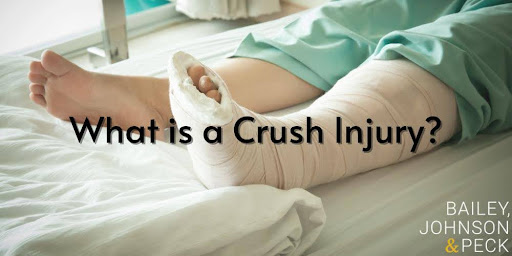Accidents can happen when you least expect them, leaving you or your loved ones with traumatic injuries such as severe head injuries, spinal cord injuries, and broken bones. Victims in major car accidents can also suffer a crush injury and crush syndrome, both of which can be fatal.
In this blog, our legal team will explore what crush injuries are, their symptoms, causes, complications, and the legal aspects of pursuing a personal injury claim in Albany, New York. If you or someone you know has suffered a crush injury due to someone else’s negligence, the Albany personal injury lawyers at Bailey, Johnson & Peck are here to help you understand your rights and seek the compensation you deserve. Call 518-456-0082 to schedule a free consultation at our law firm today.
What is a Crush Injury?
A crush injury is a traumatic injury that occurs when a body part gets compressed between two heavy objects or experiences significant force. These injuries can vary in severity, from minor bruises to life-threatening conditions, depending on the force of the direct physical crushing and the body part affected. Common body parts susceptible to crush injuries include limbs, hands, fingers, and feet.
Common Crush Injury Symptoms
Crush injuries can manifest a range of symptoms, which may include:
- Pain and tenderness in the affected area
- Swelling and bruising
- Difficulty moving or using the injured limb
- Neurological disturbances such as numbness or tingling
- Open wounds or bone fractures
- Changes in skin color (e.g., pale or bluish)
- Muscle weakness or loss of function
- Complications such as shock or organ dysfunction or failure (in severe cases)
Common Causes of Crush Injuries

Crush injuries can occur in various situations, including:
- Workplace Accidents: Machinery malfunctions, falling objects, or equipment accidents in industries like construction, manufacturing, and agriculture can result in crush injuries.
- Construction Site Accidents: Workers are at risk of being trapped or crushed by heavy machinery, collapsing structures, or materials. (Our Albany construction accident lawyers can help if you’ve been injured on a construction site.)
- Car Accidents: High-impact collisions can lead to crush injuries, especially when a vehicle is severely damaged or when a person is trapped inside. (Our Albany car accident lawyers can help if you’ve been injured by negligence.)
- Falls: A fall from a significant height can cause crush injuries, as the force of the impact can compress body parts.
- Industrial Accidents: Workers in factories, warehouses, or shipping facilities can be injured by heavy loads or equipment.
How Do Crush Injuries Happen in Car Accidents?
Car accidents are one of the most common scenarios where crush injuries occur. When a vehicle collides with another object or vehicle, the tremendous force involved can lead to various types of crush injuries. Here are a few scenarios that can explain how a crush injury occurs during a major car crash:
- Vehicle Intrusion: In a severe collision, a vehicle’s structure may become compromised, causing the car to crumple and intrude into the passenger compartment. This intrusion can lead to direct pressure on the legs and lower body, which can result in a crush injury.
- Trapped Passengers: In some cases, passengers may become trapped inside the vehicle, making it nearly impossible to exit. This confinement can result in direct trauma and crushing of the limbs, especially if the vehicle catches fire or sustains additional impacts.
- Airbag Deployment: While airbags are designed to protect occupants, they can also exert considerable force when deploying. If an airbag deploys with excessive force, it can cause crush injuries, especially to the chest and face.
- Rollover Accidents: In rollover accidents, the roof of the vehicle may collapse or deform, leading to crush injuries for occupants.
Possible Complications From Crush Injuries
Crush injury patients often suffer life-threatening, delayed complications as a result of their crushed body parts. The most common systemic complications these patients can suffer from include compartment syndrome, crush syndrome, hypovolemic shock, hyperkalemia, and kidney injuries.
Compartment Syndrome
Compartment syndrome is a soft tissue injury that occurs when increased pressure within a muscle compartment restricts blood flow, leading to tissue damage. It can cause severe pain, swelling, as well as nerve and muscle injury. Prompt medical intervention is crucial to decrease compartment pressure and prevent further complications.

Crush Syndrome
Crush syndrome, also known as traumatic rhabdomyolysis, occurs when damaged skeletal muscles release harmful substances into the bloodstream, potentially leading to metabolic abnormalities, acute renal failure, shock, or even death. Crush syndrome requires immediate medical attention for the best chances of survival.
Hypovolemic Shock
Hypovolemic shock is a state of severe blood loss, which can occur if a crush injury of an affected limb or body part leads to internal bleeding. Symptoms include rapid heart rate, low blood pressure, confusion, and pale skin. Immediate medical treatment from a trauma center is essential to stabilize the patient.
Hyperkalemia
Hyperkalemia is a condition characterized by elevated levels of potassium in the blood. Crush injuries can cause muscle breakdown, leading to the release of potassium into the bloodstream. Hyperkalemia can lead to cardiac arrest, muscle weakness, and even paralysis in the most severe cases.
Kidney Injury
You may not think that crushed and damaged muscle cells can spiral into something as severe as acute renal failure, but it definitely can. A traumatic rhabdomyolysis is a severe form of muscle breakdown that can lead to metabolic acidosis, which is when the body produces too many acids (such as lactic acid and uric acid) and your kidneys don’t flush out these acids fast enough.
Rhabdomyolysis-induced renal failure can lead to cardiac arrhythmia, nausea or vomiting, fatigue, changes in urination frequency, fatigue, confusion, and more. Preventing renal failure may require IV fluids and kidney dialysis.
If you’ve sustained these types of injuries due to negligence, contact an Albany catastrophic injury lawyer.

Treatment for Crush Injuries
Treatment for crush injuries depends on the severity of the injury and the systemic effects the patient suffers as a result of the injured muscle or body part. Doctors may suggest the following treatments:
- Stabilization: Immediate medical attention is crucial to assess and stabilize the patient’s condition. This may involve immobilizing the injured extremity, removing necrotic tissue, controlling bleeding of the injured tissue, and administering pain relief medications.
- Surgical Intervention: Severe crush injuries may require surgical procedures to repair damaged tissues, remove debris, or address complications like compartment syndrome.
- Fluid Resuscitation: Intravenous fluids may be administered to maintain blood pressure and prevent complications like hypovolemic shock. If the patient has developed metabolic acidosis as a result of muscle tissue damage, then doctors may also administer sodium bicarbonate alongside fluid therapy to help prevent renal failure. If the patient is suffering from hyperkalemia, doctors may administer calcium chloride to prevent cardiac arrhythmias.
- Monitoring: Patients with crush injuries often require close monitoring of arterial blood gas and urine output to detect and manage complications promptly.
- Renal Replacement Therapy, also known as kidney dialysis, basically replaces normal kidney function if the patient begins experiencing acute renal failure.
Can You Sue for a Crush Injury?
If you’ve sustained crush-related injuries due to someone else’s negligence, you may have grounds to file a personal injury lawsuit in Albany, New York if the person acted outside of the reasonable person standard.
To determine whether you can sue for a crush injury, consider the following factors:
- Negligence: To have a viable personal injury claim, you must demonstrate that another party was negligent and that their negligence directly resulted in your crush injury. Possible negligent parties could include drunk or distracted drivers, property owners, manufacturers of large equipment, employers, etc.
- Duty of Care: The responsible party must have owed you a duty of care, meaning they had a legal obligation to take reasonable steps to prevent harm to others.
- Causation: You must establish a clear link between the negligent actions of the responsible party and your crush injury.
- Damages: To pursue a personal injury claim, you must have suffered damages, such as medical expenses, pain and suffering, lost wages, or other losses directly related to the crush injury.
In order to prove that someone’s negligence caused your accident and your crush injury, it’s crucial to hire an experienced personal injury lawyer at Bailey, Johnson & Peck. We can gather sufficient evidence to prove that negligence occurred in your accident, and we can help you obtain a fair settlement for your suffering.
Crush Injury Damages
Albany personal injury attorneys can help you seek compensation for various types of damages related to your crush injury, including:
- Medical Expenses: This includes the costs of hospitalization, surgeries, doctor’s visits, medication, rehabilitation, and any future medical treatments related to the crush injury and secondary complications.
- Lost Wages: If your injury resulted in time off work or the inability to return to your previous job, you may be entitled to compensation for lost wages and diminished earning capacity.
- Pain and Suffering: You can seek damages for the physical and emotional pain and suffering you endured due to your crush injury.
- Disability and Disfigurement: If the crush injury or crush syndrome resulted in long-term disability or disfigurement, you may be eligible for compensation to account for the impact on your quality of life.
- Property Damage: If your personal property was damaged in the accident that caused your crush injury, you can seek compensation for repairs or replacement.
- Loss of Consortium: In some cases, a spouse or family member may be entitled to damages for the loss of companionship and support resulting from your injury.
- Punitive Damages: In cases of extreme negligence or intentional harm, the court may award punitive damages to punish the responsible party and deter similar behavior in the future.

Call Albany Personal Injury Lawyers at Bailey, Johnson & Peck Today
If you or a loved one has suffered a crush injury and crush syndrome in Albany, New York due to negligence, it’s essential to seek legal representation from experienced personal injury lawyers. At Bailey, Johnson & Peck, we understand the complexities of crush injury cases and are committed to helping you pursue the justice and compensation you deserve.
Our dedicated team will thoroughly investigate your case, gather evidence, consult with medical experts, and build a strong legal strategy to hold the negligent party accountable. We will fight tirelessly to protect your rights and help you recover the damages necessary to move forward with your life.
Don’t wait to seek justice and compensation for your crush injury. Contact the Albany personal injury lawyers at Bailey, Johnson & Peck at 518-456-0082 today for a free consultation. Allow us to guide you through the legal process with compassion and obtain justice on your behalf.




